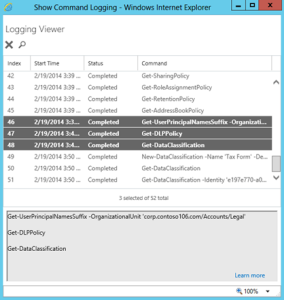Kolejną aktualizacją udostępnioną przez Exchange Team jest tym razem CU8 dla Microsoft Exchange 2013.
Aktualizację można pobrać tutaj:
Cumulative Update 8 for Exchange Server 2013
Natomiast informacje o zmianach jakie wprowadza zainstalowanie CU8 znajdziecie tutaj: KB3030080
Po zainstalowaniu aktualizacji, wasz system zmieni numer wersji na 15.0.1076.9
Aktualizacja rozwiązuje problemy opisane poniżej:
- KB 3045301 SMTP is not transported over TLS 1.1 or TLS 1.2 protocol in an Exchange Server 2013 environment
- KB 3040681 MapiExceptionTimeout error during a hierarchy synchronization process of multiple public folders in Exchange Server 2013
- KB 3037417 Outlook cannot download an OAB file in an Exchange Server 2013 environment that mixes Exchange Server 2010
- KB 3037291 Can’t add members to Outlook contact group by using MAPI over HTTP
- KB 3036952 Mailbox quota warning messages are not sent out after you migrate from Exchange Server 2010 to Exchange Server 2013
- KB 3036374 Incorrect NDR size limit message is displayed for German localization in an Exchange Server 2013 environment
- KB 3036365 „The specified address is not recognized or does not exist” error message in an Exchange Server 2013 environment
- KB 3032153 Recurring events in Calendar over DST are not adjusted on all ActiveSync devices in all Exchange Server environments
- KB 3031133 Default folders are duplicated after you migrate mailboxes to Exchange Server 2013
- KB 3031069 Mails are spoofed in Office 365 or in an Exchange Server 2013 environment
- KB 3030629 Outlook cannot open a shared folder on which a group you attend has the Reviewer permission in Exchange Server 2013
- KB 3018518 Garbled text in the Japanese „From” field in a forwarded DBCS message
- KB 3016440 Public folder mailbox quarantined
- KB 3012266 Update to increase availability address spaces to 200 in Exchange Server 2013
- KB 3011579 SaveChanges fails and generates a MAPI_E_NOT_FOUND error message on a large message body in Exchange 2013 CU6
- KB 3006861 „The SMTP address has no mailbox associated with it” error when you access a user’s mailbox by using EWS application
- KB 3003974 Improved support for MSG files in an Exchange Server 2013 environment where OPENTEXT products are used
- KB 2988060 Cannot see the auditing results for an HttpModule-based extension for MAPI over HTTP protocol in Exchange Server 2013
- KB 2986941 „An Active Directory error 0x51 occurred” error when you run the „Setup /PrepareAD” command from a DC in Exchange 2013
- KB 2961741 Exchange Server 2013 delegated setup fails when the setup account is a member of Domain Admins





 English
English  polski
polski